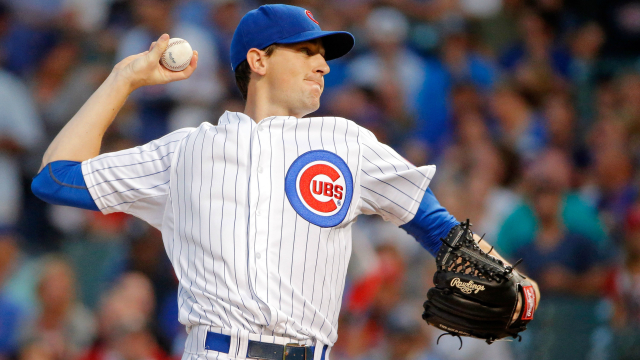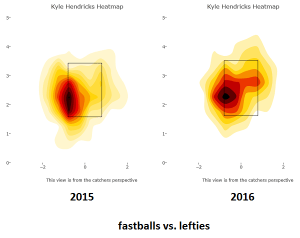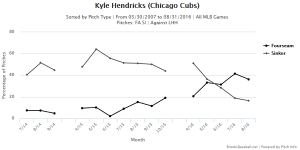Carlos Santana Will Play Left Field And Kyle Schwarber Will Not
When the 2016 World Series began Tuesday night, the Cubs had Kyle Schwarber at designated hitter. He missed the entire season with a torn ACL, but was now healthy enough to hit and run the bases, so the Cubs used him.
Once the series shifts to Wrigley Field starting tonight, the Indians will have a DH dilemma of their own. The team would have to sit either Carlos Santana or Mike Napoli, who have spent the season sharing time at first and and DH. Obviously, they don’t want to lose either of this guys:
Santana: .259/.366/.498 (121 OPS+) with 34 homers and 87 RBI
Napoli: .239/.335/.465 (104 OPS+) with 34 homers and 101 RBI
Santana and Napoli are the Tribe’s two best power hitters, and if they’re going to beat the Cubs in the World Series, they need those two guys in the lineup as often as possible. The Indians may have come up with a creative solution:
Start Carlos Santana in Left-field to meet the famous Wrigley Field ivy.
Santana, an ex-catcher turned first baseman, had made one big league appearance in the outfield. That came back in 2012, when he played left field for four innings at the end of a blowout loss. Santana did play some outfield in the minors, but that was from 2005-07.
The Indians did have Santana work out in the outfield during spring training this year in an effort to increase his versatility, though he never actually played a Cactus League game in the outfield. All he did was take fly balls, essentially.
Josh Tomlin (13-9, 4.40 ERA)
As it’s known, Tomlin is a soft-tossing north paw , albeit one who struggles with the long ball.
Tomlin has changed his approach during the playoffs. In the regular season, he threw 15% curveballs and 41% cutters. In two postseason starts, he’s thrown 39% curves and 16% cutters. It’s worth pointing out that the cutter was part of his home-run problems during the regular season. We’ll see if he continues that pattern to evade the Cubs’ barrels.
As with Hendricks, Tomlin didn’t face the Cubs during the regular season. Ben Zobrist has seen him the most — he has a .506 OPS in 21 plate appearances.
Kyle Hendricks (16-8, 2.13)
Much like Game 2, Game 3 features a pair of somewhat similar starting pitchers, but whereas Game 2 was all about power, Game 3 is about finesse. Hendricks is the better of the two crafty right-handers. His fastball sits in the upper-80’s, yet he possesses impressive command of the pitch, allowing him to get by without enduring much damage. Likewise, Hendricks has a high-grade change-up that he’s willing to use against batters of both hands. He’ll mix in an occasional curve ball as well. Hendricks did not face the Indians during the regular season, and has almost zero exposure to Cleveland’s lineup. Consider that an advantage for Hendricks.
In comparison to Jake Arrieta, Arrieta has actually gotten worse against left-handed hitters, losing the effectiveness of his best pitch while also losing his pinpoint command. This can be traced back to Arrieta losing the remarkable consistency of his mechanics. Arm speed and release point are everything, and for the last little while, Arrieta has been fighting uphill. He needs to get himself right before the playoffs.
Arrieta remains very good, as witnessed Wednesday night, but he has some stuff to work out. Kyle Hendricks, meanwhile, has nothing to work out and compared to Arrieta, Hendricks has followed kind of the opposite course. He’s gotten better against left-handed hitters. He’s essentially added a new pitch while honing his pinpoint command. His mechanics are as consistent as they’ve ever been. Right now, we’re seeing the best version of Kyle Hendricks.
In each of the last two years, Arrieta has been good against righties. In each of the last two years, Hendricks has been good against righties. Now let’s get into the lefty stuff. So much of this is about their contact. Let’s look at some data from Baseball Savant.
Last season, Hendricks ranked in the 53rd percentile in average exit velocity allowed to lefties. He ranked in the 33rd percentile if you just focus on balls hit in the air. This season, he ranks in the 94th and 92nd percentiles, respectively. Right away, that’s a positive indicator.
Also last season, Hendricks ranked in the 55th percentile in hard-hit rate minus soft-hit rate, against lefties. Once more, slightly better than average. This season, he ranks in second place. Facing lefties with the platoon advantage, Hendricks has yielded more soft-hit balls than hard-hit balls. You see his low ERA, then you see his low BABIP. We’re all trained to believe that BABIP is about defense and luck. It’s not that simple. Hendricks is harder to square up. Last year, lefties had an ISO of .208. This year they were at .121.
It’s not new to say that Hendricks is hard to hit. This has been the focus for as long as he’s had a low ERA. His peripherals haven’t meaningfully budged. The whole story is the weak contact. It’s the explanation that’s extra fun. To be clear: With more consistent mechanics, anything is possible. Hendricks has his best-ever consistency, so he also has his best-ever execution. How has this manifested? From Baseball Savant, again, here are Hendricks’ fastballs against lefties:
Hendricks is a little more on-target on the outer edge. In addition, he’s now better establishing himself on the inner edge, underneath a lefty’s hands. Compared to last year, this Hendricks is better able to go side to side. That’s important, and you can imagine how Hendricks’ sinker could be rather annoying when thrown accurately inside. An inside sinker on the edge is one of the prettiest pitches in the game. But there’s a little more to this. From Brooks Baseball, now:
That’s the other element. Hendricks has always had two fastballs, but for a while he strongly preferred his sinker. Against lefties, he’s now grown fond of his four-seamer, such that recently it’s been even more frequent. Reduced to something simpler: In the past, Kyle Hendricks was mostly a one-fastball pitcher. Now he’s a two-fastball pitcher, and he can command them both.
Hendricks has talked about how his more consistent mechanics have allowed him to throw both fastballs. It’s also helped him with his curveball, which is now commonly used to steal called strikes.
Add The Sports Daily to your Google News Feed!


